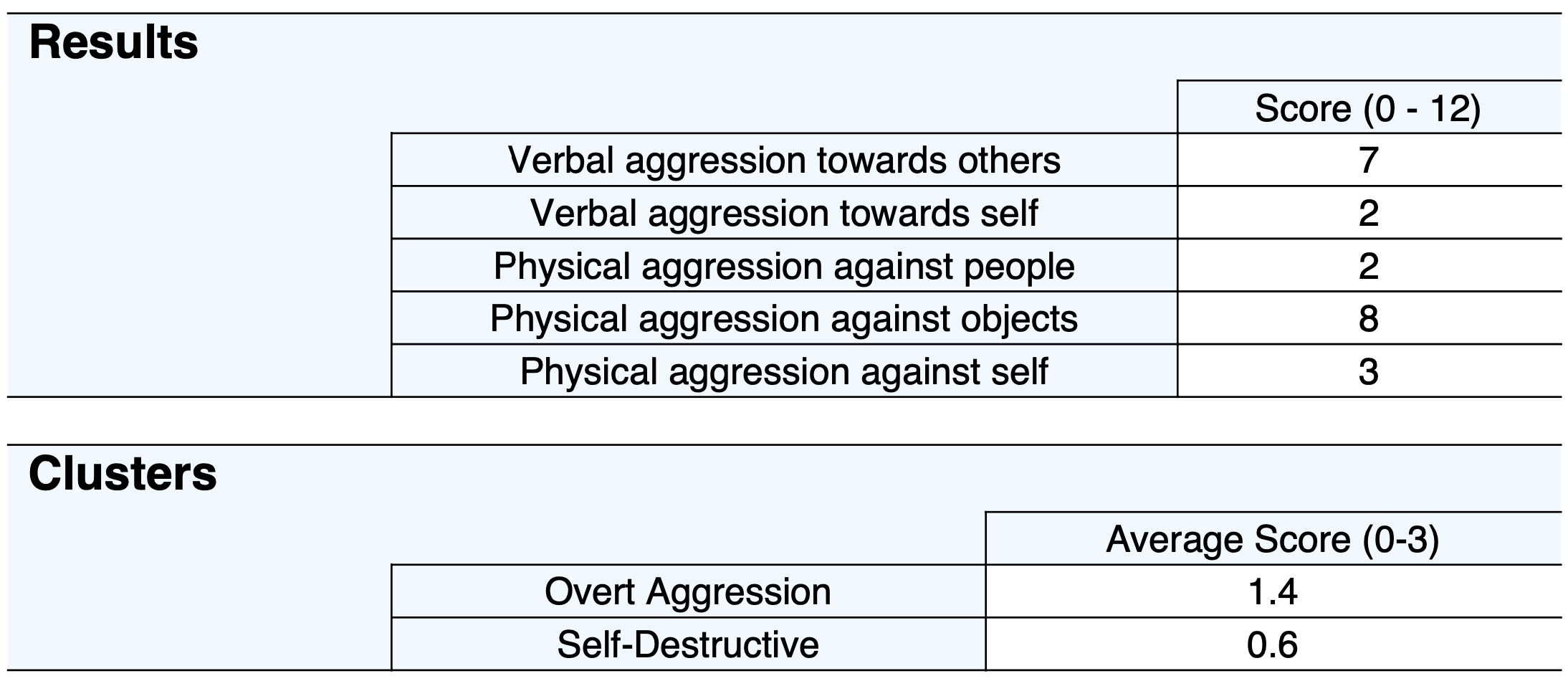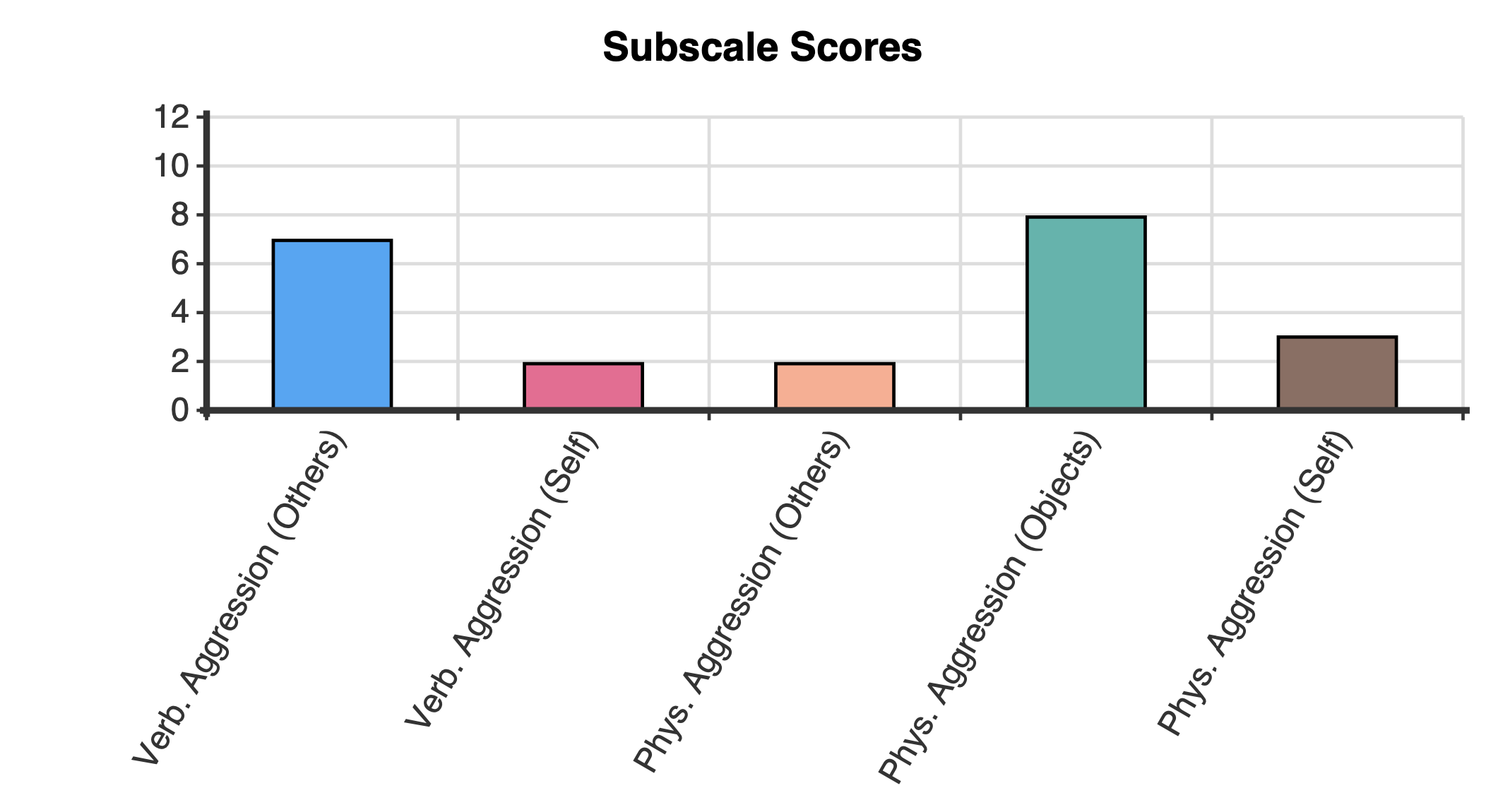The Institute for Basic Research – Modified Overt Aggression Scale (IBR-MOAS) is a 20-item assessment of the type, frequency, and severity of aggressive behaviours within autistic, traumatic brain injury, and intellectually disabled populations that is completed by a caregiver (Cohen et al., 2010). The IBR-MOAS can be used to measure the efficacy of therapy on aggressive behaviours in both clinical and community settings.
The IBR-MOAS assesses aggressive behaviours within five areas:
The IBR-MOAS was tested on over 2,000 individuals and it was found that aggression toward others and objects was highest in the youngest adults, in those in the moderate to severe range of ID, and in those with an autism spectrum diagnosis. Self-injury was highest in those in the severe to profound range of ID and in those with autism, particularly for females. Females with autism were also more likely to make the most self-deprecating statements.
Example IBR-MOAS Items:
Scores for the five areas of aggression measured are presented. Scores range from 0 – 12. Higher scores are indicative of more frequent and/or severe aggressive behaviours. The five areas of aggression are:

A graph is presented to compare the five areas when first administered and when administered more than once a graph is presented to easily demonstrate change over time.

Additionally, Cohen et al. (2010) identified two clusters that are made up of the five areas of aggression:
These are presented as an average score between 0 – 3, calculated by the sum of the items in each cluster divided by the number it items. Average scores allow for comparison between the two clusters to determine if aggression is more overt or self-destructive in nature and to tailor treatment appropriately.

If administered more than once, a graph will be presented to visualise change in these clusters over time.
The four domains, verbal aggression toward others, physical aggression against other people, physical aggression against objects, and physical aggression against self from the original OAS (Yudofsky et al. 1986) were incorporated into the IBR-MOAS form with some modifications in the wording to indicate to the rater that aggressive behaviours toward others and toward objects were being carried out in anger. In addition, a fifth domain, verbal aggression toward self, consisting of four items that document the occurrence of self-deprecating verbalisations was added. As with the other domains in the OAS, these items varied in severity from showing anger with self by making angry noises to verbal threats of violence toward self.
The IBR-MOAS is a reliable and valid measure of aggressiveness (Cohen et al., 2010). The internal reliability of the IBR-MOAS is good with Verbal aggression towards others (Cronbach’s alpha = 0.84), Verbal aggression towards self (Cronbach’s alpha = 0.84), Physical aggression against people (Cronbach’s alpha = 0.90), Physical aggression against objects (Cronbach’s alpha = 0.84), and Physical aggression against self (Cronbach’s alpha = 0.84). Inter-rater reliability ranged from 0.70 – 0.83 and test-retest reliability over a 2-week period ranged from 0.84 – 0.92 (Cohen et al., 2010). Principal Components Analysis indicated an Overt Aggression cluster (Physical aggression against objects, Physical aggression against other people, and Verbal Aggression Toward Others) and a Self Destructive cluster (Physical Aggression Against Self and Verbal Aggression Toward Self)
Cohen, I.L., Tsiouris, J.A., Flory, M.J. et al. (2010). A Large Scale Study of the Psychometric Characteristics of the IBR Modified Overt Aggression Scale: Findings and Evidence for Increased Self-Destructive Behaviors in Adult Females with Autism Spectrum Disorder. J Autism Dev Disord 40, 599–609. https://doi.org/10.1007/s10803-009-0908-z
Yudofsky, S. C., Silver, J. M., Jackson, W., Endicott, J., & Williams, D. (1986). The Overt Aggression Scale for the objective rating of verbal and physical aggression. American Journal of Psychiatry, 143, 35–39.
NovoPsych’s mission is to help mental health services use psychometric science to improve client outcomes.
© 2023 Copyright – NovoPsych – All rights reserved